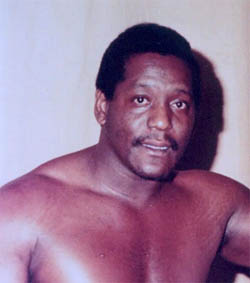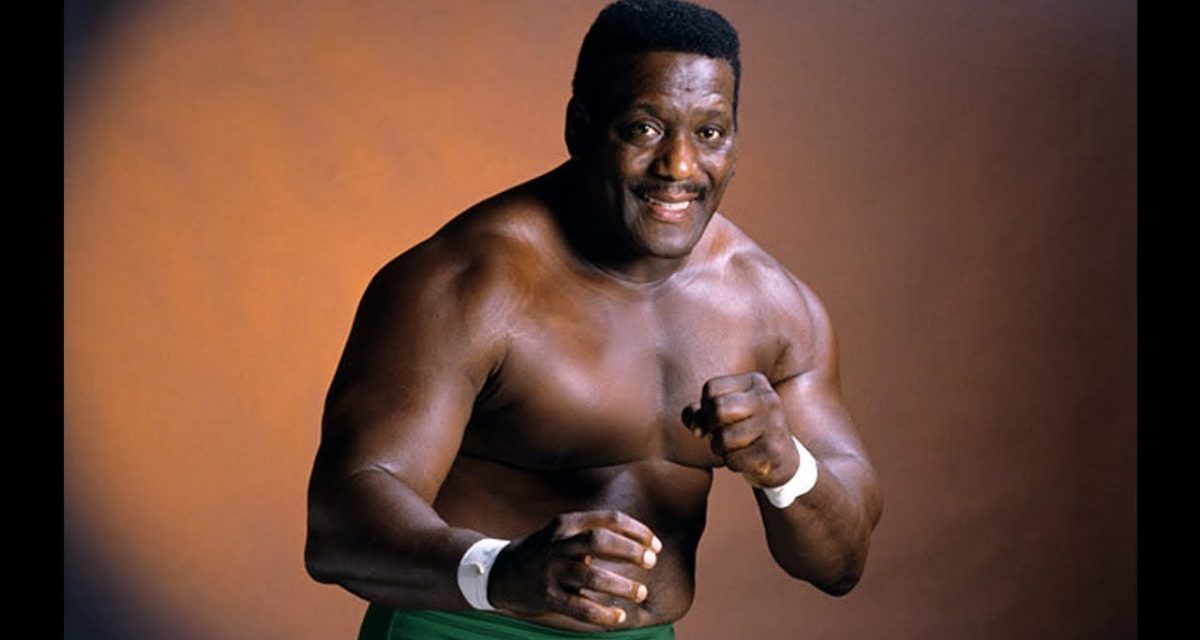Special Delivery Jones, one of the regular faces in the World Wrestling Federation heyday of the 1980s, died Sunday in Antigua, following a stroke on Wednesday. He was 63. His widow, Kay, said that he had been in fine health.
“On Wednesday, he was laughing and singing and all of that,” she told SLAM! Wrestling from Antigua. “He went to feed the dogs, and when he came back, he called my name. He said, ‘Kay.’ He showed me his fingers, and the next thing I know, his body went limp. We went to the doctor’s, and he had three-quarters of his brain bleeding, covered with blood.”

S.D. Jones as Roosevelt Jones in Florida. Photo courtesy Pete Lederberg, facebook.com/PeteLederbergsWrestlingPhotos
In the hospital, he could write but not speak. “He wrote, ‘I want to go straight to New York,'” she recalled with a chuckle. “He recognized me, and squeezed my hand”
Remembered fondly by fans as a solid competitor who could believably get in the ring with the superstar giants, even if he didn’t win very often, Jones was last seen on a national broadcast at the WrestleMania 22 WWE Hall of Fame ceremony in Chicago, where he inducted “Mr. U.S.A.” Tony Atlas.
Born Conrad Efraim on March 30, 1945, in Antigua, in the West Indies, he befriended Johnny Rodz in New York City while he was still working for the phone company. His wrestling career began in the mid-’70s, working for the WWWF, and heading on the road to the Mid-Atlantic territory, and Los Angeles, where he would win the NWA Americas Tag Team Championship with Porkchop Cash; Jones would later team with Tom Jones (no relation) to win the titles again. For some of the time, he was known as Roosevelt Jones, before the more familiar S.D., or Special Delivery, Jones came into prominence.
Regardless of his success elsewhere, the 6-foot-1, 260-pound Jones will always be remembered as a quality carpenter for the WWWF and WWF, capable of winning matches or losing believably. Often, Jones would team with bigger name stars, like Andre the Giant or Rocky Johnson to battle some despicable tag teams.
He was a fan favourite through and through, and that was genuine, said Kay Efraim.
“He loved it. He loved to be a wrestler,” she said, explaining that he got energy from his fans; “They were a part of his life for years and years and years, and we do appreciate a lot of them. He really, really loved the fans.”
She believes her husband will be fondly remembered by the fans for “his dancing, the way he wrestled, and the headbutts.”
At the first WrestleMania, in 1985 at New York City’s Madison Square Garden, Jones lost to King Kong Bundy in nine seconds. In March 2004, Jones told SLAM! Wrestling’s Steven Johnson that he was concerned that such a beating in front of a national audience would damage his career.
“I didn’t want to do it,” Jones said. But Vince McMahon persuaded him that a humiliating loss to Bundy would achieve the company’s goal of developing a monstrous rival to the likes of Hulk Hogan and Andre the Giant. After some contemplation, Jones took his medicine. “Bundy was the man then,” he said. On the plus side, Jones was not in the ring long enough to risk injury and, for good measure, “made a big, big, big, big payday.”

Fan Harris Black and S.D. Jones in the late ’80s. Courtesy Harris Black.
In a 2005 interview with SLAM! Wrestling’s Dave Hillhouse, Jones matter-of-factly addressed his career, and his role as enhancement talent. “Everybody knows it’s a show — promoters call the shots. Everybody knows that. Sometimes you don’t care, sometimes you care. Honestly, I knew there was no way I was going to get to that main championship, that’s for sure. I never even thought about it. A lot of us guys, we knew there was no way we were going to get up there,” he explained. “I was comfortable because I knew what they wanted. They want you to be there for Hulk Hogan and Pedro Morales; they want you to be an S.D. Jones, to be a Johnny Rodz. After a while you just get comfortable where you are, and that’s it. You’re doing a job, you’re making a living, and you just keep on going.”
At the WWE Hall of Fame ceremony for Atlas, Jones told stories about being on the road with his “best friend,” including impromptu weightlifting challenges in Egypt, Norway and Spain. No shrinking violet himself, Jones talked about lifting over 500 pounds himself; of course, Atlas could lift over 600 pounds.
Jones and Atlas met in 1980 in Allentown, Penn., and soon were a tag team, aiming for the WWWF tag titles. “We tried and we tried and we tried. I could not do it. I was the one that killed the tag, so I had to step aside,” Jones told the WWE Hall of Fame audience. Rocky Johnson replaced him in the tag and he and Atlas were soon champs — but they couldn’t get along, losing after three weeks.
After 22 years in the ring, Jones called it quits, lost a significant amount of weight, and began working for the New York Daily News, driving newspapers.
In November 2007, he retired and moved back to his native Antigua. His remains are at Straffie’s Funeral Home in St John’s, Antigua.
Conrad Efraim is survived by his wife, Kay, his son, two daughters, Donna and Abigail, and four grandchildren. He is predeceased by his only brother.
RELATED LINKS

